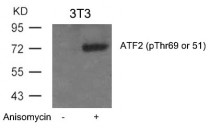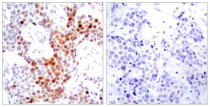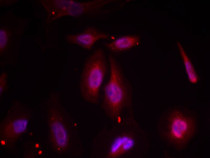ARG51534
anti-ATF2 phospho (Thr69 or 51) antibody
anti-ATF2 phospho (Thr69 or 51) antibody for ICC/IF,IHC-Formalin-fixed paraffin-embedded sections,Western blot and Human,Mouse,Rat
Gene Regulation antibody; Immune System antibody
Overview
| Product Description | Rabbit Polyclonal antibody recognizes ATF2 phospho (Thr69 or 51) |
|---|---|
| Tested Reactivity | Hu, Ms, Rat |
| Tested Application | ICC/IF, IHC-P, WB |
| Host | Rabbit |
| Clonality | Polyclonal |
| Isotype | IgG |
| Target Name | ATF2 |
| Antigen Species | Human |
| Immunogen | Peptide sequence around phosphorylation site of threonine 69 or 51 (D-Q-T(p)-P-T) derived from Human ATF2. |
| Conjugation | Un-conjugated |
| Alternate Names | EC 2.3.1.48; Histone acetyltransferase ATF2; Activating transcription factor 2; cAMP-dependent transcription factor ATF-2; Cyclic AMP-dependent transcription factor ATF-2; CREB2; HB16; CREB-2; Cyclic AMP-responsive element-binding protein 2; cAMP-responsive element-binding protein 2; CRE-BP1; cAMP response element-binding protein CRE-BP1; TREB7 |
Application Instructions
| Application Suggestion |
|
||||||||
|---|---|---|---|---|---|---|---|---|---|
| Application Note | * The dilutions indicate recommended starting dilutions and the optimal dilutions or concentrations should be determined by the scientist. |
Properties
| Form | Liquid |
|---|---|
| Purification | Antibodies were produced by immunizing rabbits with KLH-conjugated synthetic phosphopeptide. Antibodies were purified by affinity-chromatography using epitope-specific phosphopeptide. In addition, non-phospho specific antibodies were removed by chromatogramphy using non-phosphopeptide. |
| Buffer | PBS (without Mg2+ and Ca2+, pH 7.4), 150mM NaCl, 0.02% Sodium azide and 50% Glycerol. |
| Preservative | 0.02% Sodium azide |
| Stabilizer | 50% Glycerol |
| Concentration | 1 mg/ml |
| Storage Instruction | For continuous use, store undiluted antibody at 2-8°C for up to a week. For long-term storage, aliquot and store at -20°C. Storage in frost free freezers is not recommended. Avoid repeated freeze/thaw cycles. Suggest spin the vial prior to opening. The antibody solution should be gently mixed before use. |
| Note | For laboratory research only, not for drug, diagnostic or other use. |
Bioinformation
| Database Links | |
|---|---|
| Gene Symbol | ATF2 |
| Gene Full Name | activating transcription factor 2 |
| Background | Transcriptional activator, probably constitutive, which binds to the cAMP-responsive element (CRE) (consensus: 5'-GTGACGT[AC][AG]-3'), a sequence present in many viral and cellular promoters. Interaction with JUN redirects JUN to bind to CRES preferentially over the 12-O-tetradecanoylphorbol-13-acetate response elements (TRES) as part of an ATF2-c-Jun complex. |
| Function | Transcriptional activator which regulates the transcription of various genes, including those involved in anti-apoptosis, cell growth, and DNA damage response. Dependent on its binding partner, binds to CRE (cAMP response element) consensus sequences (5'-TGACGTCA-3') or to AP-1 (activator protein 1) consensus sequences (5'-TGACTCA-3'). In the nucleus, contributes to global transcription and the DNA damage response, in addition to specific transcriptional activities that are related to cell development, proliferation and death. In the cytoplasm, interacts with and perturbs HK1- and VDAC1-containing complexes at the mitochondrial outer membrane, thereby impairing mitochondrial membrane potential, inducing mitochondrial leakage and promoting cell death. The phosphorylated form (mediated by ATM) plays a role in the DNA damage response and is involved in the ionizing radiation (IR)-induced S phase checkpoint control and in the recruitment of the MRN complex into the IR-induced foci (IRIF). Exhibits histone acetyltransferase (HAT) activity which specifically acetylates histones H2B and H4 in vitro. In concert with CUL3 and RBX1, promotes the degradation of KAT5 thereby attenuating its ability to acetylate and activate ATM. Can elicit oncogenic or tumor suppressor activities depending on the tissue or cell type. [UniProt] |
| Highlight | Related Antibody Duos and Panels: ARG30227 Phospho ATF2 Antibody Panel (Total, pT69, pT71) Related products: ATF2 antibodies; ATF2 ELISA Kits; ATF2 Duos / Panels; Anti-Rabbit IgG secondary antibodies; |
| Research Area | Gene Regulation antibody; Immune System antibody |
| Calculated MW | 55 kDa |
| PTM | Phosphorylation of Thr-69 by MAPK14 and MAPK11, and at Thr-71 by MAPK1/ERK2, MAPK3/ERK1, MAPK11, MAPK12 and MAPK14 in response to external stimulus like insulin causes increased transcriptional activity. Phosphorylated by PLK3 following hyperosmotic stress. Also phosphorylated and activated by JNK and CaMK4. ATM-mediated phosphorylation at Ser-490 and Ser-498 stimulates its function in DNA damage response. Phosphorylation at Ser-62, Thr-73 and Ser-121 activates its transcriptional activity. Phosphorylation at Thr-69 or Thr-71 enhances its histone acetyltransferase (HAT) activity. |
Images (3) Click the Picture to Zoom In
-
ARG51534 anti-ATF2 phospho (Thr69 or 51) antibody WB image
Western blot: Extracts from 3T3 cells untreated or treated with Anisomycin stained with ARG51534 anti-ATF2 phospho (Thr69 or 51) antibody.
-
ARG51534 anti-ATF2 phospho (Thr69 or 51) antibody IHC-P image
Immunohistochemistry: Paraffin-embedded Human breast carcinoma tissue stained with ARG51534 anti-ATF2 phospho (Thr69 or 51) antibody (left) or the same antibody preincubated with blocking peptide (right).
-
ARG51534 anti-ATF2 phospho (Thr69 or 51) antibody ICC/IF image
Immunofluorescence: methanol-fixed HeLa cells stained with ARG51534 anti-ATF2 phospho (Thr69 or 51) antibody.








